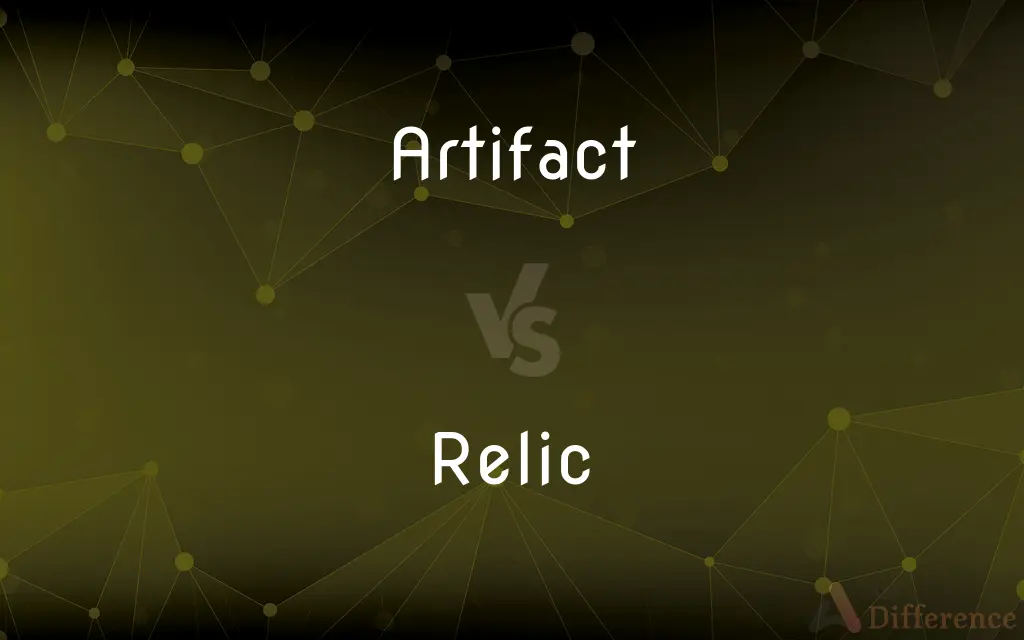Artifact vs. Relic — What's the Difference?
Edited by Tayyaba Rehman — By Fiza Rafique — Updated on October 30, 2023
An artifact is a man-made object of historical or cultural significance. A relic is an ancient object, often with religious or sentimental value. Both relate to the past, but artifacts emphasize human creation while relics highlight age and reverence.

Difference Between Artifact and Relic
Table of Contents
ADVERTISEMENT
Key Differences
Artifact and Relic are terms frequently employed to describe items from the past, but they carry distinct connotations. An artifact is fundamentally a man-made object, typically from an earlier time, that holds cultural or historical significance. On the other hand, a relic tends to be an old or ancient object, often preserving historical, cultural, or sometimes religious importance.
When examining the origins of these terms, artifacts predominantly point towards human creation and craftsmanship. They may encompass tools, art, writings, or any creation that reveals insights into the past civilizations or cultures. In contrast, relics often carry an aura of reverence. The term relic is commonly associated with religious artifacts or fragments, such as a bone of a saint or a piece of the True Cross.
In museums or collections, artifacts serve to display the expertise, way of life, or the aesthetic preferences of past societies. They provide a tangible connection to history and often help in understanding human evolution, both culturally and technologically. Relics, however, often hold a deeper, sometimes spiritual or sentimental value. People might be drawn to relics not just for their age but for the veneration they command due to their association with significant religious or historical figures or events.
In summation, while both artifacts and relics connect us to history, the term artifact emphasizes human creation and design, whereas relic underscores antiquity, reverence, and oftentimes religious significance.
Comparison Chart
Definition
A man-made object with historical or cultural value.
An old object with historical, cultural, or religious significance.
ADVERTISEMENT
Association
Human creation and craftsmanship.
Age, reverence, often religious.
Typical Examples
Tools, pottery, writings.
Bones of saints, pieces of the True Cross.
Primary Emphasis
Human endeavor and historical insight.
Veneration, spiritual or sentimental value.
Usage in Museums
Displays human evolution and cultural practices.
Evokes reverence, religious or historical significance.
Compare with Definitions
Artifact
An item representing past human life or culture.
This artifact tells us a lot about how they lived.
Relic
An object revered for its association with a saint or religious figure.
Pilgrims traveled miles to see the holy relic.
Artifact
Something created by humans, often for a specific purpose.
The arrowhead is an artifact from native tribes.
Relic
A cherished item that has survived from an earlier time.
That family heirloom is a relic from our ancestors.
Artifact
An object or tool made by humans, especially in archaeological contexts.
The dig site revealed numerous artifacts from the Bronze Age.
Relic
A surviving trace or remnant of something that once existed.
The ancient building is a relic of a bygone era.
Artifact
A product of human artistry or craftsmanship.
The intricately designed vase is a valuable artifact.
Relic
Something regarded as a rare example, especially in a changed context.
The old typewriter is a relic in this digital age.
Artifact
A human-made object from an earlier time, showcasing historical significance.
The museum displayed an artifact from ancient Rome.
Relic
An object from the past, especially with historical or religious significance.
The church displayed a relic believed to be from a saint.
Artifact
An object produced or shaped by human craft, especially a tool, weapon, or ornament of archaeological or historical interest.
Relic
In religion, a relic usually consists of the physical remains of a saint or the personal effects of the saint or venerated person preserved for purposes of veneration as a tangible memorial. Relics are an important aspect of some forms of Buddhism, Christianity, Islam, Shamanism, and many other religions.
Artifact
Something viewed as a product of human conception or agency rather than an inherent element
"Morality is an artifact of human culture, devised to help us negotiate social relations" (Michael Pollan).
Relic
An object surviving from an earlier time, especially one of historical interest
A museum of railway relics
Artifact
A phenomenon or feature not originally present or expected and caused by an interfering external agent, action, or process, as an unwanted feature in a microscopic specimen after fixation, in a digitally reproduced image, or in a digital audio recording.
Relic
Something that has survived the passage of time, especially an object or custom whose original culture has disappeared
"Corporal punishment was a relic of barbarism" (Cyril Connolly).
Artifact
An inaccurate observation, effect, or result, especially one resulting from the technology used in scientific investigation or from experimental error
The apparent pattern in the data was an artifact of the collection method.
Relic
Something cherished for its age or historic interest.
Artifact
An object made or shaped by human hand or labor.
Relic
An object kept for its association with the past; a memento.
Artifact
An object made or shaped by some agent or intelligence, not necessarily of direct human origin.
Relic
An object of religious veneration, especially a piece of the body or a personal item of a saint.
Artifact
Something viewed as a product of human agency or conception rather than an inherent element.
Relic
Or relics A corpse; remains.
Artifact
A finding or structure in an experiment or investigation that is not a true feature of the object under observation, but is a result of external action, the test arrangement, or an experimental error.
The spot on his lung turned out to be an artifact of the X-ray process.
Relic
That which remains; that which is left after loss or decay; a remaining portion.
Artifact
(archaeology) An object, such as a tool, ornament, or weapon of archaeological or historical interest, especially such an object found at an archaeological excavation.
The dig produced many Roman artifacts.
Relic
Something old and outdated, possibly kept for sentimental reasons.
Artifact
(biology) An appearance or structure in protoplasm due to death, the method of preparation of specimens, or the use of reagents, and not present during life.
Relic
(religion) A part of the body of a saint, or an ancient religious object, kept for veneration.
Artifact
(computing) A perceptible distortion that appears in an audio or video file or a digital image as a result of applying a lossy compression or other inexact processing algorithm.
This JPEG image has been so highly compressed that it has unsightly artifacts, making it unsuitable for the cover of our magazine.
Relic
To cause (an object) to appear old or worn, to distress.
Artifact
(museology) Any object in the collection of a museum. May be used sensu stricto only for human-made objects, or may include ones that are not human-made.
Relic
That which remains; that which is left after loss or decay; a remaining portion; a remnant.
The relics of lost innocence.
The fragments, scraps, the bits and greasy relics.
Artifact
A product of human workmanship; - applied esp. to the simpler products of aboriginal art as distinguished from natural objects.
Relic
The body from which the soul has departed; a corpse; especially, the body, or some part of the body, of a deceased saint or martyr; - usually in the plural when referring to the whole body.
There are very few treasuries of relics in Italy that have not a tooth or a bone of this saint.
Thy relics, Rowe, to this fair urn we trust,And sacred place by Dryden's awful dust.
Artifact
Any product of human workmanship; - applied both to objects made for practical purposes as well as works of art. It is contrasted to natural object, i.e. anything produced by natural forces without the intervention of man.
Relic
Hence, a memorial; anything preserved in remembrance; as, relics of youthful days or friendships.
The pearls were spilt;Some lost, some stolen, some as relics kept.
Artifact
A structure or appearance in protoplasm due to death, method of preparation of specimens, or the use of reagents, and not present during life.
Relic
An antiquity that has survived from the distant past
Artifact
An object, oservation, phenomenon, or result arising from hidden or unexpected causes extraneous to the subject of a study, and therefore spurious and having potential to lead one to an erroneous conclusion, or to invalidate the study. In experimental science, artifacts may arise due to inadvertant contamination of equipment, faulty experimental design or faulty analysis, or unexpected effects of agencies not known to affect the system under study.
Relic
Something of sentimental value
Artifact
A man-made object taken as a whole
Common Curiosities
Are all relics religious in nature?
No, while many relics have religious significance, they can also hold historical or sentimental value.
Are all artifacts old?
Not necessarily, but most artifacts have historical or cultural significance from an earlier time.
Can an artifact hold religious significance?
Yes, an artifact can have religious significance, but its primary emphasis is on human creation.
What is the primary distinction between an artifact and a relic?
An artifact emphasizes human creation, while a relic focuses on age and often religious or sentimental value.
Can a relic be man-made?
Yes, relics can be man-made, especially if they have significant historical, sentimental, or religious value.
Can a building be considered an artifact?
Yes, buildings or structures can be deemed artifacts if they represent historical or cultural significance.
Can a relic be a recent item?
Typically, relics are considered old or ancient, especially with a sense of reverence or importance.
How are artifacts important to archaeologists?
Artifacts provide tangible evidence of past human life, culture, and evolution, crucial for archaeological studies.
Is a piece of art from the Renaissance an artifact or relic?
It's primarily an artifact due to its human creation, but could be seen as a relic due to its age and significance.
Can modern tools be considered artifacts?
In the future, they might be if they offer insights into our current civilization or culture.
Are all religious items relics?
Not all. Relics typically have an added layer of veneration, age, or association with a significant figure or event.
Do relics always have intrinsic value?
Not always. Their value often lies in their historical, religious, or sentimental significance rather than material worth.
Can an item be both an artifact and a relic?
Yes, if it's a man-made object with both historical significance and revered due to age or association.
How are artifacts preserved?
Artifacts are often preserved using various techniques, including controlled environments, chemical treatments, or restorations.
Why might people venerate relics?
Due to their association with significant religious or historical figures, events, or the sentiments they evoke.
Share Your Discovery

Previous Comparison
Presume vs. Assume
Next Comparison
Watertight vs. AirtightAuthor Spotlight
Written by
Fiza RafiqueFiza Rafique is a skilled content writer at AskDifference.com, where she meticulously refines and enhances written pieces. Drawing from her vast editorial expertise, Fiza ensures clarity, accuracy, and precision in every article. Passionate about language, she continually seeks to elevate the quality of content for readers worldwide.
Edited by
Tayyaba RehmanTayyaba Rehman is a distinguished writer, currently serving as a primary contributor to askdifference.com. As a researcher in semantics and etymology, Tayyaba's passion for the complexity of languages and their distinctions has found a perfect home on the platform. Tayyaba delves into the intricacies of language, distinguishing between commonly confused words and phrases, thereby providing clarity for readers worldwide.














































